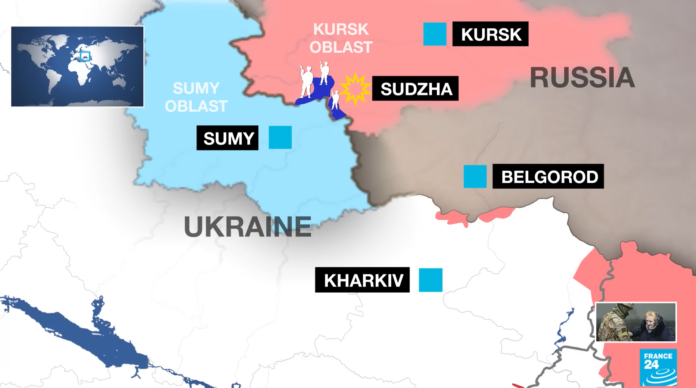
As of August 16, the Ukrainian army’s large-scale offensive into Russia’s Kursk Oblast has entered its 10th day. Reports indicate that over 12,000 Ukrainian troops have crossed into Russian territory, capturing Sudzha, a border town, and 82 additional settlements, thus occupying a region approximately 60 kilometers wide and 20 kilometers deep. According to the new commander-in-chief of the Armed Forces of Ukraine, Colonel General Oleksandr Syrskyi, they have seized 1,150 square kilometers of Russian land and established a military administration.
The Ukrainian Armed Forces (UAF) strategically drew elite combat forces and veterans from across the front line, concentrating advanced mechanized and motorized equipment. Under the cover of limited anti-aircraft weapons and mobile artillery, the UAF covertly assembled, swiftly launched a surprise assault, and exploited Russian negligence and a weak, dispersed frontline in Kursk. This allowed them to penetrate Russian defenses in multiple columns, including through deception tactics, enabling rapid territorial gains.
The Russian response thus far has involved various airstrikes, artillery interdiction, and extensive use of drones to target and destroy Ukrainian mechanized equipment. However, they have yet to deploy large-scale ground forces for a full-scale counteroffensive. To outside observers, it appears that, beyond defending key population centers, Russia prioritized the emergency construction of rear defensive lines to prevent further Ukrainian advances.
After 10 days of Ukrainian raids, it is evident that the Russian military, both in terms of capacity and intent, is not fully prepared to launch an immediate large-scale counterattack. The current Russian strategy seems more oriented toward containing the Ukrainian forces by reinforcing defensive positions, delaying their advance, and using superior air power, artillery, and drones to inflict casualties. A full counteroffensive may be considered only after the arrival of reinforcements.
In past key operations during the Russo-Ukrainian war, Russian intentions have been more transparent. For instance, the Russian strategy after February 24, 2022, can be comprehensively understood through wartime information consolidation, subsequent analyses, and notably, Lukashenko’s invasion map of Ukraine. Similarly, the Ukrainian counteroffensive in Zaporizhzhia, launched in May 2023, despite achieving limited tangible progress, reveals through NATO reports and captured battle plans that the UAF aimed to break through Russian defenses within two weeks and advance south to Berdiansk, a strategy aimed at isolating Russia’s southern front. This battle plan was relatively clear in its intent.
This surprise attack by the Ukrainian army caught the Russian forces completely off guard, with even the U.S. claiming they were unaware of the operation beforehand. For Ukraine, the minimum objective seems to be leveraging the campaign’s successes for political propaganda and potentially securing additional resources.
The Russo-Ukrainian war, characterized by minefields, fortifications, drones, and long-range firepower, has evolved into a protracted war of attrition. Russia, having mobilized its military industry and receiving direct arms supplies from North Korea and Iran, contrasts sharply with Ukraine’s deteriorating situation. Ukraine’s military-industrial complex has been severely damaged, its weapons and ammunition are depleted, NATO’s military aid is insufficient, and a significant portion of the Ukrainian population has fled the country.
While the overall level of equipment and military technology between the Russian and Ukrainian armies is relatively comparable, Russia’s advantages in ammunition supply, troop reinforcements, and particularly its greater numbers of drones, loitering munitions, and artillery support, have allowed it to make gradual advances in the eastern regions of Ukraine.
Given the scale of the Ukrainian military operation in Kursk, involving tens of thousands of troops, it seems unlikely that the sole purpose was to create an international spectacle or boost morale, as was the case with past symbolic military actions.
While gaining territory between the two armies might be one reason, it seems insufficient as the primary motive given the significant resources involved. Strategically important targets such as Sudzha, which has a gas crossing and serves as a junction for several highways, do not seem crucial within the broader context of Russia’s military objectives in Ukraine.
The Ukrainian operation in the Kursk region presents a paradoxical situation. Military analysts argue that given the current state of the Ukrainian army, particularly its limited and highly valuable mechanized units, these forces should ideally be reserved as resilient defenses. Their role would be to slow down the Russian offensive and inflict maximum casualties on Russian troops, especially given the uncertainty of receiving further large-scale military assistance.
From this perspective, the decision to commit these forces to capturing and holding militarily insignificant territory in Kursk seems both incomprehensible and strategically unsound. The Ukrainian forces, once deployed in Kursk, would be vulnerable to superior Russian air and drone strikes, forcing them to remain in a precarious position on Russian soil.
However, for Ukrainian and NATO politicians, as well as certain Russian and Ukrainian commentators with vested interests, the immediate survival of these Ukrainian reserves may be secondary. As the war enters a phase of attrition, with a slow but steady trend, Ukrainian politicians are increasingly struggling to leverage the situation to secure more international aid. Meanwhile, NATO policymakers are becoming more hesitant to pour resources into a conflict that increasingly appears to be a bottomless pit, especially as Russia shows resilience and even growth in strength.
If the Kursk operation succeeds and NATO responds with increased assistance, particularly in rebuilding Ukraine’s ground and air forces, even significant losses among Ukrainian reserves could be justified. This could potentially extend the war, giving Ukraine the means to prolong the conflict. From the perspective of Ukraine and NATO, prolonging the war increases the likelihood of destabilizing the Russian regime, which they consider a key element in achieving a long-term victory over Russia.
Ukraine’s military venture in the Kursk Oblast echoes the desperate strategies seen throughout history when nations, facing unfavorable tides in war, resort to high-risk operations with ambitious but difficult-to-achieve objectives. In such cases, countries often deplete their already strained war resources in a final, desperate bid to turn the tide.
Source: understandingwar, France 24



